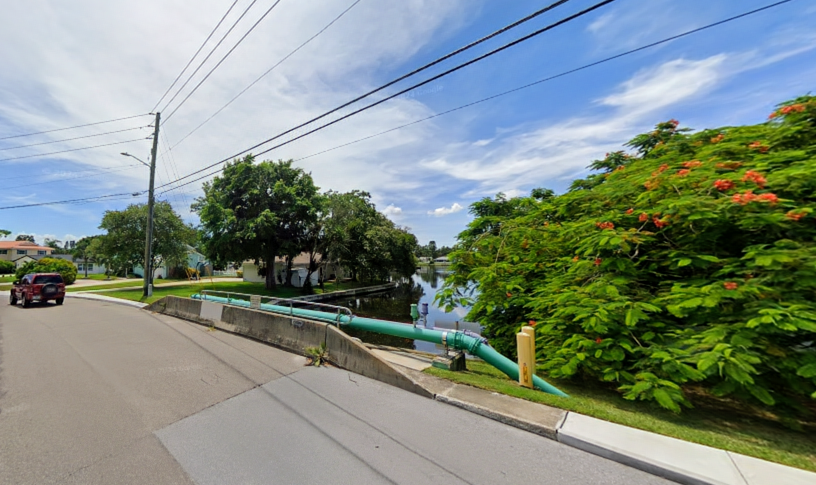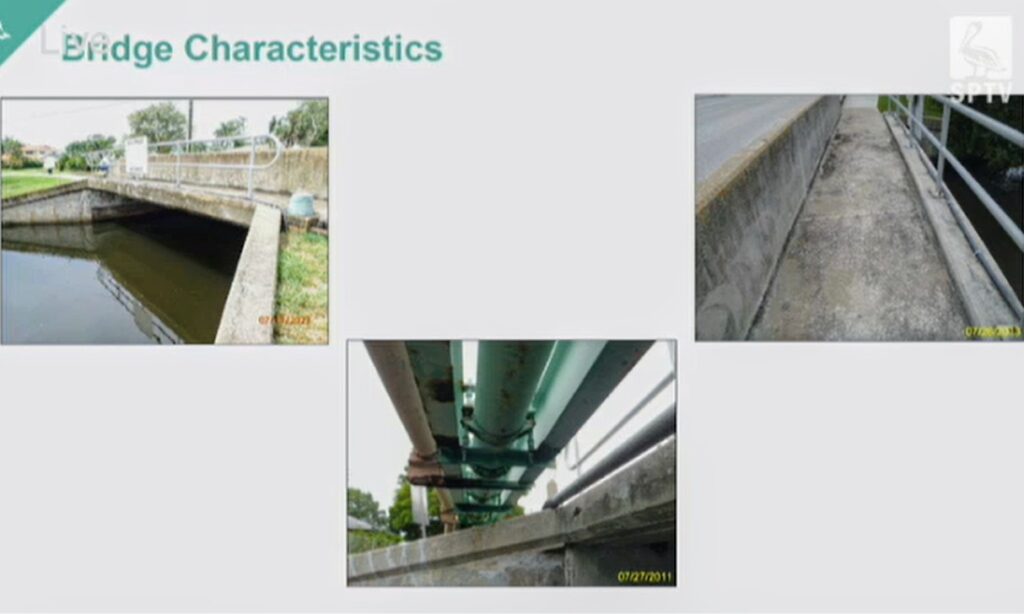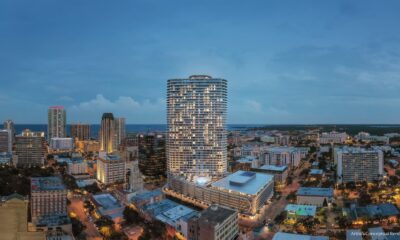Thrive
Council approves replacing deteriorating St. Pete bridge

A St. Petersburg neighborhood adjacent to flood-prone Shore Acres will soon receive a much-needed new bridge as part of an over $5 million project.
City council members unanimously approved multiple agreements for the Venetian Boulevard NE Bridge replacement project Thursday afternoon. Background documents note that Tampa-based Cone & Graham, the lead contractor, was the “only responsive and responsible bidder.”
The bridge opened over the Venetian Canal in 1957 has exceeded its intended lifespan. Documents state it is “experiencing ongoing deterioration of its bridge elements and bulkhead retaining walls.”
“The bridge is classified as functionally obsolete,” said Brejesh Prayman, capital improvements director. “That does not mean the bridge is not safe.”

A graphic showing the bridge’s current conditions and narrow sidewalks. Screengrab.
Prayman told the council that its outdated design prohibits adaptability. He said the structure is too narrow to accommodate bicycles safely and does not comply with Americans with Disabilities Act (ADA) accessibility standards.
Ensuring bridge safety and functionality is paramount as Shore Acres is the city’s lowest-lying neighborhood. The area routinely floods during high tides and rain events. Named storms passing hundreds of miles offshore have caused widespread inundation.
In addition, Venetian Isles juts farther east into Tampa Bay than any other area of St. Petersburg. Prayman said he has experienced challenges driving through the neighborhood.
He explained that the nearly 70-year-old bridge was constructed with “Sonovoid” precast concrete slabs. Prayman called that an “acceptable method” that promotes speed and reduces costs.
However, he said federal agencies have “adjusted their national Bridge Index rating” for structures built with Sonovoid due to the hollow sections corroding. Prayman said saltwater intrusion “triggered that national movement.”
He used the nearby 40th Avenue Bridge, which connects Northeast Park with Shore Acres, as an example. City officials found hidden structural issues in 2017 that required emergency repairs.
They uncovered further deterioration as the process unfolded, prompting closure and a replacement. The 40th Avenue Bridge reopened in July 2023.
“Because it (corrosion) was on the inside of the beam, we never saw the rate and accelerated amount of degradation to the concrete structure,” Prayman said. He added that those structures in saltwater environments present a “substantial risk.”

The new bridge will also feature a more aesthetically pleasing railing. Screengrab.
Documents note that in January 2016, the city launched a Bridge Inventory Management initiative that prioritized 16 replacements. It identified the Venetian Bridge “due to its structural deterioration and functional obsolescence.”
Cone & Graham will replace it with a single-span structure atop steel pile foundations with a “Florida slab beam superstructure.” The $4.04 million contract includes concrete traffic railings, rip-rap shore protection, new seawalls, sidewalk installation, utility relocation and roadway reconstruction to the north and south.
The Florida Department of Transportation will inspect the new bridge biannually. The council approved a $750,000 design contract with Chicago-based H.W. Lochner and a $700,000 architectural and engineering agreement with Kisinger Campo & Associates, headquartered in Tampa.
The project will impact neighboring residences and traffic. However, Prayman said it will increase connectivity by mitigating a vertical curve.
It will also increase boat clearance from 5.25 to 5.68 feet, and contractors will install six-foot sidewalks and increase the shoulder width. Prayman said that would allow “for some better flushing of water.”
The new bridge will also feature decorative railings that match other city structures. Following the council’s approval, city officials will work with contractors to create an ideal design and ensure correct engineering calculations.
Prayman said the project includes extensive construction settlement and vibration monitoring that, if triggered, would alert city officials and the surrounding neighbors via their cell phones. He said administrators would then “immediately shut down operations,” stabilize the ground and slowly reconvene the process.
Prayman expects construction to commence in the winter and conclude 12 months later. He hopes to have a set timeline in about three weeks to schedule a public meeting in September.
“The bridge is expected to be constructed in one single phase,” Prayman added. “That will help with expediting construction and increase safety for construction personnel, as well as the traveling public.”

A graphic highlighting the project’s detour and work area. Screengrab.
He called the bridge’s location “ideal” for traffic control. However, Councilmember Ed Montanari, who represents the area, noted previous challenges with similar projects.
“A couple of these bridges that have been done in my City Council district along the way, whether it’s the 40th Avenue Bridge, the Tanglewood Bridge and now this one, there always seems to be some sort of issue,” Montanari said. “And I want to get some of these questions out of the way on the front end.”
Prayman said the contractor would ensure driveway access for residents, even if they must implement a temporary entrance. Officials will establish bypass water and sewer lines and schedule any shutdowns during low-flow hours.








Patricia A. Cook
August 18, 2024at9:48 am
This bridge is Long Overdue for replacing. I complained to the City of St Petersburg, 20 years ago when I was President of Shore Acres Association. I mentioned a few bridges not accessible to the disabled, strollers etc. This includes the Shore Acres bridge at Horseshoe Place. Just a thought but what took the City 20 years to decide to do this?
Ryan
August 18, 2024at7:15 am
This seems like an opportunity to raise the bridge height allowing greater use of the waterway. As it is, residents with taller boats are often stuck until low tide and they have to time it right to get home under low tide. Raising less than an inch isn’t going to make a difference.